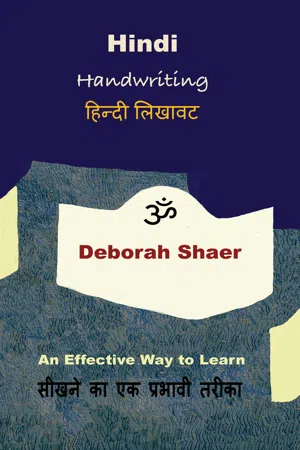
- 172 pages
- English
- ePUB (mobile friendly)
- Available on iOS & Android
About This Book
Hindi Handwriting is a holistic educational language book with a focus on learning how to write Hindi and takes a creative approach to learning. It also looks through the kaleidoscopic lens of dyslexia.
Most people have no real grasp of the breadth and depth of dyslexia, what it is or how to support children and adults. Educators who don't know that they don't know, exacerbate the problem when they have no real awareness. The disadvantages, aside from academia, affect so many areas of the dyslexic's daily life. The British Dyslexia Association estimates 10% of the UK population as having dyslexia, though there are likely to be far more who are unaware and cannot fathom their experience of inconsistencies seemingly arising out of left field.
Hindi language learners, whether dyslexic or not, who experience difficulty in knowing which directions the letters go, will find a solution in the workbook section. Each letter is accompanied by arrows and numbers to indicate the direction and sequence in addition to guidance for unfamiliar sounds and how to pronounce them.
Hindi Handwriting is uniquely different from other Hindi language books as it expands upon the pragmatic elements of language by exploring the spiritual roots. It does this by highlighting how meditation helps to optimise study and concentration, clarifies symbolic meanings in the sacred AUM shape and sound and makes links between the goddess of learning, Sarasvati, and neuroscience. Lastly, it explores the social and material dimensions of the culture and religion.
Frequently asked questions
Information
Part I
Holistic Education
Chapter 1
Self-Discovery Through Learning Styles
- Tactile: handouts, fact sheets or flash cards.
- Kinaesthetic: movement. This can be translated into the action of writing, as well as breathing and stretching when energy becomes low.2
- Auditory: the sound of the teacher’s voice.
- Interpersonal-feelings: interaction between peers.
- Musical: learning songs in Hindi.
- Visual: images and colour give shape to what you are learning; see ‘Colours’ section, which combines words with the related colour.
- Logical: rational thought and mathematical solution based.

- Scrivener, J., 2005, Learning Teaching: The Essential Guide to English Language Teaching, Oxford: Macmillan, p. 64.↩︎
- Frank, R., 2001, Body of Awareness: A Somatic and Developmental Approach to Psychotherapy. Santa Cruz, USA: Gestalt Press.↩︎
Chapter 2
Challenges to Learning: Dyslexia
Looking Through a Dyslexic Lens
Exercise Part 1
| च | ज | ञ |
|---|---|---|
| cha | ja | nya |
Exercise Part 2
- Revisit the devanagari characters in Exercise 1.
- Take a few moments to focus on each of the shapes of the devanagari script.
- Without looking at the first grid in Exercise 1, identify the corresponding devanagari characters by writing in the English sound letters in the grid below.
Exercise Part 3: A Visual Way of Understanding Dyslexia

- Gupte, A. Screenwriter, 2007. Like Stars on Earth. PVR Pictures and Aamir Khan Production: India. Hindi with English subtitles.↩︎
- Siegel, D. J., 1999, The Developing Mind: Toward a Neurobiology of Interpersonal Experience. New York: The Guilford Press↩︎
Chapter 3
Memory, Emotions and the Brain
Table of contents
- Hindi Handwriting
- About The Author
- Dedication
- Copyright Information ©
- Acknowledgement
- Figure no. Images
- Preface
- Introduction
- Part I
- Chapter 1
- Chapter 2
- Chapter 3
- Part II
- Chapter 4
- Vowels
- Consonants
- Chapter 5
- Chapter 6
- Chapter 7
- Chapter 8
- Chapter 9
- Chapter 10
- Part III
- Chapter 11
- Chapter 12
- Chapter 13
- Chapter 14